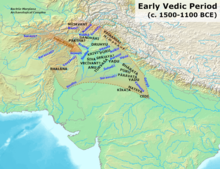The Poureai alias Purus were an Indo-Aryan tribal alliance or a confederation of tribes that existed between c. 1700–1400 BCE.[6] There were several factions of Purus, one being the Bharatas.[3] The Purus and the Bharatas were the two most prominent tribes in most of the Rigveda.[6] The chief of tribe was called Rajan[1] The Purus rallied many other groups against King Sudas of the Bharata, but were defeated in the Battle of the Ten Kings (RV 7.18, etc).
| Puru Paurava | |
|---|---|
| Confederation | |
 The Purus and other early Vedic tribes | |
| Ethnicity | Indo-Aryan |
| Location | Northern Indian subcontinent |
| Varna | Kshatriya[1] |
| Descended from | Pururavas[2] |
| Parent tribe | First tribe of Chandra clan |
| Branches | Bharatas[3] |
| Language | Vedic Sanskrit[4] |
| Religion | Historical Vedic religion[5] |
| Surnames | Puruvamsh |
Etymology
editThe name Puru is of possible Indo-Aryan origin.[7]
Rigveda
editIn Mandala 6, it is recalled that Purukutsa, chieftain of Purus, had destroyed autumnal forts in the Afghan mountains.[8][9] In Mandala 4, it is stated that as a result of his Ashvamedha (Horse Sacrifice) with the horse Daurgaha, his son Trasadasyu was born.[10][8]
In Mandala 4, Trasadasyu is the chieftain of the Purus. In addition to being the son of Purukutsa, Trasadasyu is also described as Gairikṣita, meaning descendant of Girikṣit.[10][8] Trasadasyu lived on the western side of the Indus River (Sindhu) while Mandala 4 was being composed, but he also moved into the land of Seven Rivers and defeated the Anu-Druhyus and Yadu-Turvashas. He molded the conquered tribes and the Purus into the Pancha-janah (Five Peoples). To celebrate his victory he conducted an Ashvamedha with his horse, Dadhrikā. Dadhrikā is extolled in RV 4.38-40, and in these hymns, Dadhrikā is stated to have become a divine being, the sacrificial horse of the Ashvamedha, and a symbol of Puru and Indo-Aryan dominance. Trasadasyu's son was Tṛkṣi.[8]
Scholars who adhere to Hermann Grassmann's interpretation of Rigveda 7.92.2 state that by Mandala 7, the Purus had reached the Sarasvati river.[11][8]
Claimants
editLater rulers may have claimed lineage to the Puru clan to bolster their legitimacy. Modern scholars conjecture that Porus may have been a Puru king. However, Porus is not known in Indian sources.[12]
See also
editNotes
edit- ^ a b Renou, Louis (1957). Vedic India. p. 130.
- ^ www.wisdomlib.org (2015-04-15). "Genealogy of the princes of the lunar race [Chapter CXXXIX]". www.wisdomlib.org. Retrieved 2022-10-03.
- ^ a b Scharfe, Hartmut E. (2006), "Bharat", in Stanley Wolpert (ed.), Encyclopedia of India, vol. 1 (A-D), Thomson Gale, pp. 143–144, ISBN 0-684-31512-2
- ^ Baldi, Philip (1983). An Introduction to the Indo-European Languages. Southern Illinois University Press. pp. 51–52. ISBN 978-0-8093-1091-3.
- ^ Witzel, Michael (2004). "Kalash Religion (extract from 'The Ṛgvedic Religious System and its Central Asian and Hindukush Antecedents". In Griffiths, A.; Houben, J.E.M. (eds.). The Vedas: Texts, language, and ritual. Groningen: Forsten. pp. 581–636.
- ^ a b Erdosy, George; Witzel, Michael (1995). Language, Material Culture and Ethnicity. The Indo-Aryans of Ancient South Asia: Rgvedic history: poets, chieftains and politics. De Gruyter. p. 204.
- ^ Witzel, Michael (1999). "Aryan and non-Aryan Names in Vedic India. Data for the linguistic situation, c. 1900-500 B.C." (PDF). Harvard Oriental Series Opera Minora. 3: 19. Archived from the original (PDF) on 28 July 2011.
- ^ a b c d e Erdosy, George; Witzel, Michael (1995). Language, Material Culture and Ethnicity. The Indo-Aryans of Ancient South Asia: Rgvedic history: poets, chieftains and politics. De Gruyter. pp. 237–242.
- ^ Jamison & Brereton 2014, p. 801.
- ^ a b Jamison, Stephanie; Brereton, Joel (2014). The Rigveda: The Earliest Religious Poetry of India. Oxford University Press. pp. 619–626, 699. ISBN 9780199370184.
- ^ Jamison & Brereton 2014, p. 1004.
- ^ Nonica Datta, ed. (2003). Indian History: Ancient and medieval. Encyclopaedia Britannica / Popular Prakashan. p. 222. ISBN 978-81-7991-067-2.
Not known in Indian sources, the name Porus has been conjecturally interpreted as standing for Paurava, that is, the ruler of the Purus, a clan known in that region from ancient Vedic times.
References
edit- Kosambi, Damodar Dharmanand (1966). Ancient India: A History of its Culture and Civilisation. Delhi: Pantheon Books. pp. 81–83.
- Prakash, Buddha (1964). Political and Social Movements in Ancient Panjab. Delhi, Patna, Varanasi: M. Banarsidass. p. 77.